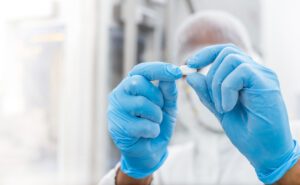Neurofibromatosis Type 1
What is neurofibromatosis type 1?
Neurofibromatosis type 1 is a rare genetic disorder of the nervous system. The nervous system mainly affects how nerve cells form and grow, but neurofibromatosis causes tumors to form on this healthy nerve tissue. Usually these tumors are benign, but sometimes they can become cancerous.
What causes neurofibromatosis type 1?
Neurofibromatosis type 1 is caused by genetic defects (mutations) that either are inherited or spontaneously occur. The specific genes that are involved depend on the type of neurofibromatosis. In type 1, the NF1 gene is mutated, causing a loss of the protein neurofibromin, which normally helps regulate cell growth.
The inheritance pattern for NF1 is autosomal dominant.
What are the symptoms of neurofibromatosis?
Signs and symptoms of neurofibromatosis type 1 are the following:
- Flat, light brown spots on the skin and freckling in the armpits or groin area
- Tiny bumps on the iris of the eyes
- Soft bumps on or under the skin (neurofibromas)
- Bone deformities
- Larger than average head size and short stature
- Learning disabilities
How is neurofibromatosis type 1 diagnosed?
A health care provider will begin with a review of family and personal medical history, a clinical evaluation can usually make a diagnosis of neurofibromatosis. In addition, an eye exam, ear exam, genetic tests, and various imaging tests may also be used to confirm a diagnosis.
If there is no family history of the disease, there must be at least two signs of the condition for a diagnosis to be made.
What are the available treatments for neurofibromatosis type 1?
Although there is no cure for any type of neurofibromatosis, treatment and monitoring can help control the symptoms of the disease, maximize healthy growth and development, and manage complications as soon as they arise.
The following procedures can help to treat severe symptoms or complications of neurofibromatosis:
- Surgery to remove tumors
- Stereotactic radiosurgery
- Auditory brainstem implants and cochlear implants
Where can I find more information on neurofibromatosis type 1?
Neurofibromatosis Articles

Neurofibromatosis Type 1: A Mother’s Struggle Living with Thousands of Tumors

“An Event to End NF” Helped Teen Raise Funds, Awareness for Neurofibromatosis
Mom Advocates for More Research After Daughter’s NF1 Diagnosis


This Mom Ran the NY Marathon to Raise Neurofibromatosis Awareness

In 10 Years, “Links for Lauren” Has Raised $500K for Neurofibromatosis





